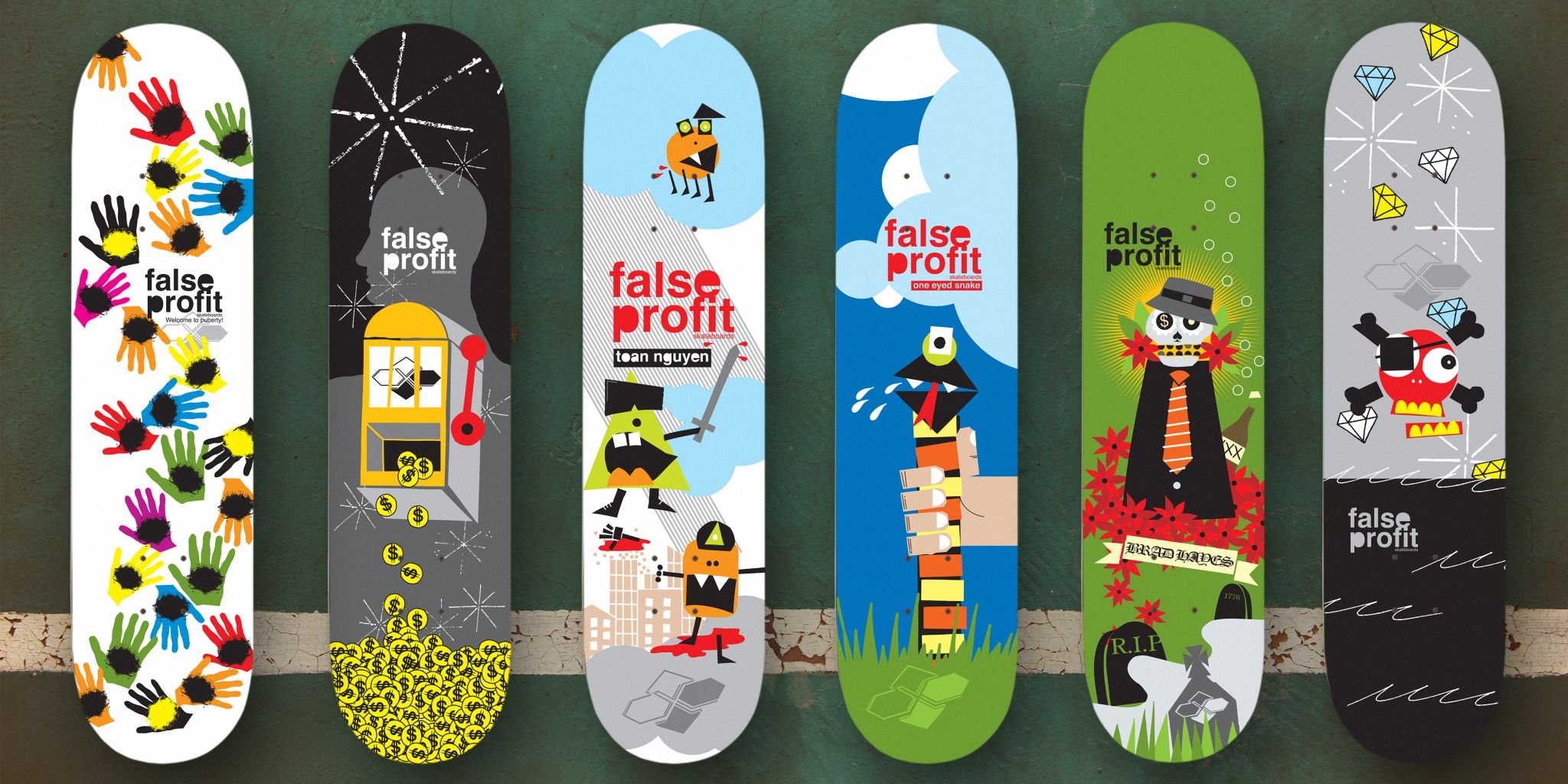
False Profit Skateboards
Case Study: False Profit Skateboards - A Creative Collaboration Rooted in Nostalgia and Innovation
Background
False Profit Skateboards, a brand founded by skateboarder and entrepreneur Mario Duaz, quickly made a name for itself in the competitive world of skateboarding. With a roster of talented riders that included up-and-coming ams and renowned pros like Brad Hayes and Toan Nguyen, False Profit had the foundation of a promising brand. Yet, Mario and I, longtime friends and collaborators, felt the need to push the brand’s direction into something truly distinctive—an identity that set it apart from the many skateboarding brands flooding the market at the time.
The Challenge
While skateboarding brands often follow similar design aesthetics—bold graphics, edgy logos, and loud colors—Mario and I wanted to create something that had a deeper, more thoughtful visual appeal. Our goal was to blend modern design elements with a nostalgic, yet human touch, creating a skateboard line that not only stood out but also had lasting cultural value.
The challenge was clear: how could we merge skateboarding culture with timeless design in a way that felt fresh, unique, and meaningful?
The Solution
Inspired by my own personal collection of vintage children’s books—particularly the artwork from the '50s and '60s—Mario and I decided to create a one-of-a-kind drop that would combine elements of European Modernism with nostalgic children’s book illustrations. These works, often filled with whimsical characters and simple yet striking color schemes, offered a visual language that was both playful and sophisticated.
We decided on a collection of six skateboard decks, each with a design that took inspiration from these classic illustrations. Along with the decks, we introduced a line of apparel and accessories that complemented the overall aesthetic. The intention was not just to sell skateboards but to create a curated experience, one that brought together elements of art, design, and skate culture in a way that had not been done before.
Key Features
Design Aesthetic: The skateboard decks featured clean lines, muted tones, and bold graphics inspired by mid-century modern design and vintage children’s book illustrations. Each deck told a story and invited the viewer to engage with the artwork beyond the usual flashy graphics often seen in the skateboarding world.
"Blue Ball Concave": In addition to the artwork, we introduced a new concave design for the decks—the "Blue Ball Concave." Drawing inspiration from the early '90s Prime Wood Boards, this mellow concave provided a comfortable and familiar ride, offering a sense of nostalgia for seasoned skaters while still feeling fresh for newer riders.
Product Range: The collection included not only the six skate decks but also apparel and accessories that featured the same vintage-inspired designs. This allowed the brand to expand its identity beyond just skateboards and into the wider culture of skateboarding fashion.
The Outcome
The collaboration was a resounding success. The distinctive design, which blended modern sensibilities with nostalgic elements, resonated with skateboarders and collectors alike. The decks were unique, but they also appealed to a broader audience beyond traditional skate culture. The incorporation of the Blue Ball Concave, which offered a blend of comfort and nostalgia, also became a standout feature that many skaters appreciated.
As False Profit continued to grow, the brand released additional guest pro boards and collaborations with other artists, but this original collection remains one of the standout moments in the brand’s history. It was not only a creative expression of the brand’s ethos but also a testament to the power of combining art, nostalgia, and innovation in skateboarding design.
Conclusion
This project was a rewarding experience, as it allowed me to merge my passion for art and design with my love for skateboarding culture. Working with Mario to create something truly unique for False Profit Skateboards showed me the importance of staying true to creative vision while being open to new ideas and influences. Ultimately, this collection became a perfect example of how design can elevate a product and make it resonate with people on a deeper level—something that remains a core value for both myself and the False Profit brand.
My Role
Creative Direction








